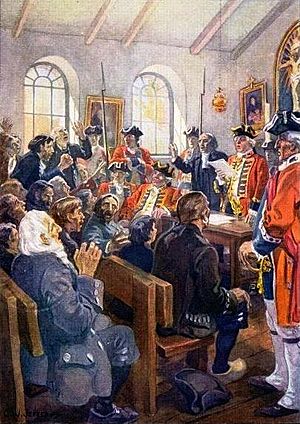Royal Proclamation of 2003 facts for kids
The Royal Proclamation of 2003 is an important document from Queen Elizabeth II. It officially recognizes a sad event in history called the Great Upheaval. This was when the British government forced thousands of Acadian settlers to leave their homes in what is now Nova Scotia and New Brunswick. This happened because of an order from King George II on July 28, 1755.
The Royal Proclamation was made on December 31, 2003. It also set July 28 of every year as "A Day of Commemoration of the Great Upheaval." The first day was July 28, 2005, which was 250 years after the original deportation order was signed.
What Was the Great Upheaval?
The Acadians were French-speaking people who had lived in parts of Canada for a long time. They were mostly farmers and fishers. In the mid-1700s, there was a big conflict between Britain and France. The British wanted the Acadians to swear loyalty to the British Crown, but many Acadians wanted to stay neutral.
Because of this, the British decided to deport the Acadians. This forced removal, known as the Great Upheaval, lasted until 1763. It had terrible results. Thousands of Acadians died from sickness, in shipwrecks, or in prison camps. Many were sent to other British colonies in America or even to England.
Why Was This Proclamation Made?
The idea for this proclamation started way back in 1763. At that time, some Acadians who had been forced to leave sent a request to King George III. They wanted him to acknowledge what had happened to them. But the King never replied.
Many years later, in the 1990s, a Cajun lawyer named Warren A. Perrin brought this old request back to life. Cajuns are descendants of Acadians who settled in Louisiana. Mr. Perrin wanted Queen Elizabeth II to officially acknowledge the Great Upheaval. He wasn't asking for money, just for the historical facts to be recognized.
After 13 years of talks, Mr. Perrin and his supporters convinced the Canadian government to issue the royal proclamation. The document was signed by Adrienne Clarkson, who was the Governor General at the time. She was the Queen's representative in Canada.
What Does the Proclamation Say?
The Royal Proclamation of 2003 officially states several important things:
- It recognizes that the Acadian people have made a great contribution to Canadian society for almost 400 years.
- It confirms that on July 28, 1755, the British Crown decided to deport the Acadian people.
- It acknowledges that the deportation, known as the Great Upheaval, had tragic results. Many thousands of Acadians died from disease, shipwrecks, or in prison camps.
- The Queen acknowledges these historical facts and the suffering the Acadians went through.
- It expresses hope that the Acadian people can move past this difficult part of their history.
- It makes it clear that Canada is now a sovereign country, not a British colony.
- It states that the proclamation does not mean the Crown in Canada is taking any legal or financial responsibility for what happened. It also doesn't affect anyone's rights.
- Finally, it officially designates July 28 of every year as "A Day of Commemoration of the Great Upheaval," starting in 2005.


